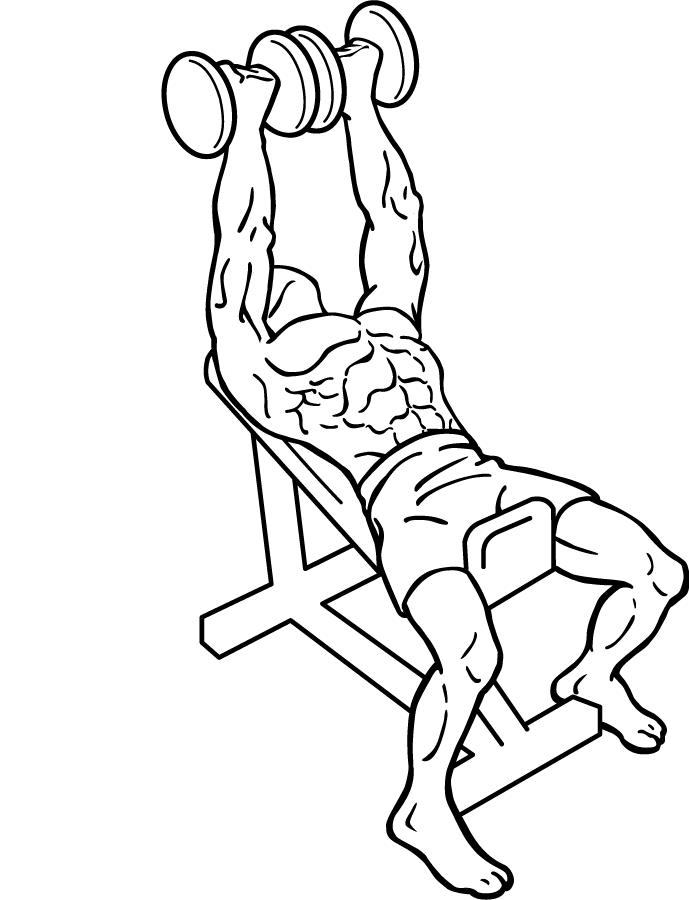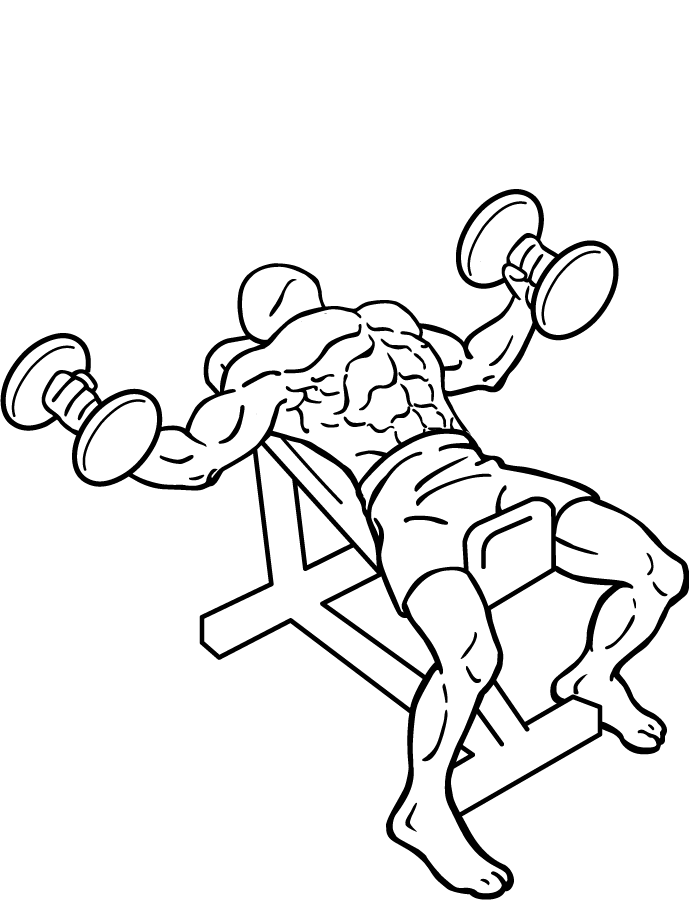Last Updated on September 30, 2022
Incline Flyes with a Twist is a powerful variation of the traditional incline fly that targets the upper chest muscles while adding an extra twist for greater muscle activation. This exercise is perfect for anyone looking to sculpt and strengthen their chest, especially those seeking a unique challenge that enhances muscle definition and growth. In this guide, we’ll explore the benefits, technique, variations, common mistakes, and tips to optimize this exercise in your workout routine.
What are Incline Flyes with a Twist?
Incline Flyes with a Twist are performed on an incline bench with dumbbells, emphasizing the upper chest. The key difference from standard flyes is the inward twist at the top of the movement, which intensifies the contraction in the chest muscles. This twist engages the muscle fibers differently, providing a new stimulus for muscle growth and sculpting the chest for a fuller, more defined look.
Muscles Worked:
- Pectoralis Major (Upper Chest): The primary target, especially the upper portion of the chest.
- Anterior Deltoids: The front shoulder muscles assist in stabilizing the movement.
- Stabilizer Muscles: Various smaller muscles in the shoulders and arms that support the motion, aiding balance and control.
Benefits of Incline Flyes with a Twist
- Enhanced Upper Chest Activation:
- The incline angle focuses on the upper chest, and the inward twist at the top maximizes the contraction, promoting muscle growth and strength.
- Increased Range of Motion:
- This variation of the fly allows for a deeper stretch and more intense contraction, improving flexibility and muscle development.
- Better Mind-Muscle Connection:
- The twisting motion requires concentration, enhancing the mind-muscle connection, which is vital for optimizing muscle activation and growth.
- Shoulder Stability and Mobility:
- By engaging the anterior deltoids and stabilizer muscles, this exercise helps strengthen and stabilize the shoulders, reducing the risk of injury during other upper body movements.
- Versatile Exercise for All Levels:
- Suitable for beginners when performed with light weights and for advanced lifters by increasing resistance or incorporating intensity techniques like slow negatives.
How to Perform Incline Flyes with a Twist Properly
Step-by-Step Guide:
- Set Up the Bench:
- Adjust an incline bench to a 30-45 degree angle. Ensure the angle is appropriate to target the upper chest effectively without shifting too much focus onto the shoulders.
- Position Yourself:
- Lie back on the bench with your feet flat on the floor for stability. Your hips, back, and head should be in contact with the bench throughout the movement.
- Hold the Dumbbells Correctly:
- Grasp a dumbbell in each hand and start with your arms extended out to the sides, palms facing up, and the dumbbells parallel to the floor. This is your starting position.
- Perform the Fly Motion:
- Keeping a slight bend in your elbows, raise the dumbbells upward in an arc until they meet above your chest. As the dumbbells come together, twist your wrists inward so that your pinky fingers face each other. This twist maximizes chest contraction.
- Control the Descent:
- Slowly reverse the arc motion, bringing the dumbbells back to the starting position. Maintain control to engage the chest muscles fully and avoid strain.
- Repeat for Repetitions:
- Aim for 3–4 sets of 8–12 reps, focusing on form, control, and the inward twist to fully engage the chest muscles.
Common Mistakes to Avoid
Despite the straightforward nature of the incline flyes with a twist, several common mistakes can reduce the exercise’s effectiveness or increase injury risk:
- Using Too Much Weight:
- Heavy weights can compromise form and make it difficult to control the movement, increasing shoulder strain. Start with a manageable weight that allows for full range of motion.
- Locking the Elbows:
- Keep a slight bend in your elbows to avoid straining your joints and to maintain tension in your chest muscles. Locked elbows reduce muscle engagement and increase injury risk.
- Setting the Bench Angle Incorrectly:
- Setting the incline too high (above 45 degrees) may shift the focus away from the chest to the shoulders. Stick to an angle between 30 and 45 degrees for optimal chest engagement.
- Not Engaging the Core:
- Failing to engage your core can cause your back to arch, reducing chest activation and potentially straining the lower back. Maintain core tension throughout the movement.
- Rushing Through the Reps:
- Controlled movement is key for maximum muscle activation. Avoid rushing through the reps, especially during the twisting motion at the top.
Variations of Incline Flyes with a Twist
Adding variety to your routine can keep your muscles challenged and engaged. Here are some variations of incline flyes with a twist:
- Single-Arm Incline Fly with Twist:
- Perform the exercise with one arm at a time. This variation enhances the mind-muscle connection and engages the core for stability.
- Incline Cable Fly with Twist:
- Using a cable machine instead of dumbbells allows for constant tension throughout the range of motion, intensifying the contraction at the top when you twist.
- Incline Fly with Resistance Bands:
- Attaching resistance bands to the bench provides added tension during the descent and ascent, making the twist even more challenging and effective.
- Incline Flyes on a Stability Ball:
- For an advanced variation, perform the flyes on a stability ball instead of a bench. This engages the core muscles and challenges balance, adding a functional fitness element.
- Incline Fly to Press Combo:
- Alternate between a fly and a press movement in the same set. This combination targets the chest from multiple angles and maximizes upper body engagement.
Tips for Maximizing Your Incline Flyes with a Twist
- Warm-Up Properly:
- Begin your workout with dynamic stretches and light exercises for the chest and shoulders, like band pull-aparts or push-ups, to prepare your muscles and joints.
- Focus on the Squeeze:
- At the top of the movement, pause briefly when twisting your wrists to maximize the contraction. Visualize squeezing your chest muscles to enhance muscle activation.
- Progressive Overload:
- Gradually increase the weight or reps over time to challenge your muscles and promote growth. Progressive overload is key for continuous development.
- Maintain Consistent Breathing:
- Inhale as you lower the dumbbells and exhale as you bring them together. Proper breathing ensures you stay relaxed and focused during the movement.
- Use a Spotter for Heavy Sets:
- If you’re lifting heavier weights, having a spotter can ensure you maintain proper form and assist you if needed.
Incline Flyes with a Twist vs. Other Chest Exercises
Understanding how this exercise compares to other chest movements can help you create a balanced chest workout:
- Incline Flyes vs. Flat Flyes: Incline flyes emphasize the upper chest, while flat flyes target the middle portion. Combining both variations ensures a well-rounded chest routine.
- Incline Flyes vs. Incline Press: While the incline press focuses on building power and mass, incline flyes (especially with a twist) isolate and shape the chest muscles, enhancing definition.
- Incline Flyes vs. Pec Deck: The pec deck machine provides a similar motion but with more support, making it a suitable alternative for those needing extra stability or recovering from injuries.
The Science Behind Incline Flyes with a Twist
The incline position activates the clavicular head of the pectoralis major, while the twist at the top maximizes muscle contraction, leading to increased muscle growth. The combination of these actions allows for deep muscle fiber recruitment, improving overall chest definition.
Studies show that varying angles in chest exercises results in more complete muscle development. By incorporating the incline fly with a twist, you target muscle fibers that are not fully engaged in flat or decline exercises.
Nutrition and Recovery: Supporting Your Chest Growth
A well-structured incline fly routine should be complemented with proper nutrition and recovery strategies:
- Protein Intake: Aim for 1.6–2.2 grams per kilogram of body weight to support muscle repair and growth.
- Carbohydrates and Fats: Balance your intake with complex carbs (e.g., quinoa, sweet potatoes) and healthy fats (e.g., avocados, olive oil) to fuel and recover from intense workouts.
- Hydration: Drink plenty of water, especially before and after workouts, to optimize muscle function and recovery.
- Sleep: Prioritize 7–9 hours of sleep per night to allow your muscles to repair and grow. Incorporate active rest days and light mobility work to promote recovery.
Integrating Incline Flyes with a Twist into Your Workout Routine
For optimal results, it’s essential to incorporate incline flyes with a twist effectively into your workout regimen. Here’s a sample routine to help you build strength and sculpt the upper chest:
- Warm-Up:
- Begin with 5-10 minutes of dynamic stretches focusing on the chest, shoulders, and arms (e.g., shoulder rotations, chest openers, band pull-aparts).
- Compound Movement:
- Start your chest workout with a heavy compound movement like the Incline Dumbbell Press or Flat Bench Press (4 sets of 8–10 reps) to build overall chest mass and strength.
- Incline Flyes with a Twist:
- Perform 3–4 sets of 10–12 reps. Focus on the arc motion and the inward twist at the top for maximum chest contraction and definition.
- Cable Flyes:
- Follow up with Cable Flyes (3 sets of 12–15 reps) to keep the tension constant throughout the movement, which helps enhance chest development.
- Push-Ups:
- Finish off with Incline Push-Ups (3 sets to failure) to further exhaust the upper chest and enhance muscle endurance.
- Cool Down:
- Complete your workout with static stretches focusing on the chest, shoulders, and arms (5–10 minutes) to promote flexibility and recovery.
Frequently Asked Questions About Incline Flyes with a Twist
1. What is the best bench angle for incline flyes with a twist?
- The optimal angle is between 30 and 45 degrees. This range targets the upper chest effectively while minimizing the strain on the shoulders. An angle higher than 45 degrees may shift focus away from the chest and more onto the shoulders.
2. How much weight should I use for incline flyes with a twist?
- Start with a weight that allows you to maintain proper form and control throughout the exercise. For beginners, lighter weights are recommended to focus on technique. As you progress, increase the weight gradually to challenge your muscles while ensuring that you can still perform the twist comfortably.
3. Can incline flyes with a twist replace flat flyes?
- Incline flyes with a twist are an excellent addition to your routine but should not entirely replace flat flyes. Flat flyes target the middle chest, while incline flyes emphasize the upper chest. Including both variations ensures a balanced chest workout.
4. Is the twist necessary, and what does it do?
- The twist at the top of the movement is crucial for maximizing muscle engagement in the upper chest. It adds a peak contraction, which enhances the definition and shape of the muscle. If you’re new to the exercise, you may start with a basic fly motion before incorporating the twist as you become more comfortable.
5. How often should I do incline flyes with a twist?
- Integrate this exercise into your chest routine 1–2 times per week. Avoid overtraining by allowing at least 48 hours of recovery time between chest workouts to ensure muscle repair and growth.
Final Thoughts
Incline Flyes with a Twist are a powerful addition to any chest workout, offering a unique way to target and sculpt the upper chest muscles while engaging the shoulders and stabilizers. By focusing on proper form, maintaining a consistent tempo, and incorporating a twist at the top, you can achieve better muscle activation and growth.
Whether you are aiming to add mass, build strength, or enhance the shape of your chest, incline flyes with a twist can help you reach your goals. Make this exercise a regular part of your routine, pair it with compound movements, and combine it with a balanced diet and adequate recovery for best results.
Stay consistent, keep challenging yourself, and watch your upper chest transform with the Incline Flyes with a Twist.


Exercise images by Everkinetic.






